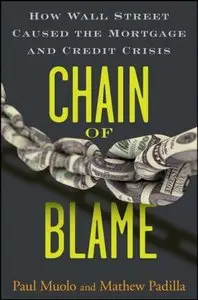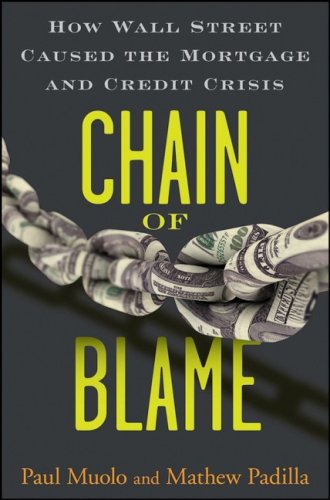Chain of Blame: How Wall Street Caused the Mortgage and Credit Crisis By Paul Muolo, Mathew Padilla
Publisher: Wiley | Pages: 352 | 2008-07-08 | ISBN: 0470292776 | PDF | 1,5MB
Publisher: Wiley | Pages: 352 | 2008-07-08 | ISBN: 0470292776 | PDF | 1,5MB
In the summer of 2007, the subprime empire that Wall Street had built all came crashing down. On average, fifty lenders a month were going bust-and the people responsible for the crisis included not just unregulated loan brokers andcon artists, but also investment bankers and home loan institutions traditionally perceived as completely trustworthy.Chain of Blame chronicles this incredible disaster, with a specific focus on the players who participated in such a fundamentally flawed fiasco. Authors Paul Muolo and Mathew Padilla, well-regarded journalists for National Mortgage News and the Orange County Register respectively, reveal the truth behind how this crisis occurred, what individuals and institutions-from lenders and brokers to some of the biggest investment banks in the world-were doing during this critical time, and who is ultimately responsible for what happened.
Summary: You wanted to know
Rating: 5
This book tells it like it is. It’s clear, well ordered, and very readable. But it’s a little scary to realize how greed can control a country like ours.
Summary: An easy to read explanation of the Mortgage crisis; needs some editing though
Rating: 3
This book clearly spells out what went wrong to precipitate the mortgage crisis that catapulted the financial markets into a global meltdown. The book uses simple language to describe complex concepts, which is very helpful to the financial novice like myself. In this sense, this book is wonderful.
However, the book is way too long. Some whole paragraphs are repeated almost verbatim in different chapters. Each paragraph chronicles the life and times of another major mortgage company. While this concept is ok for telling stories about the individuals involved in the business, it makes for highly repetitive reading, as the mistakes made by one company are often made by others. The first 150 pages is a tough slog of similar people and similar stories, but the book picks up steam in the final 150.
Finally, while this book does a great job of explaining the mortgage industry and their role in the financial crisis, the authors make a cursory explanation of what truly happened on the Wall Street side of things. (This isn’t too unexpected because the authors are mortgage experts.) For example, there is basically no mention of the subsequent credit crunch that was precipitated by the sub-prime mortgage disaster.
For a good explanation of what went wrong on the Wall Street side of things, I recommend ‘The Trillion Dollar Meltdown: Easy Money, High Rollers, and the Great Credit Crash’. That book is not an easy read, because the author expects the reader to have a solid understanding in Wall Street lingo. But ‘Chain of Blame’ is a useful primer.
Summary: Pleanty of blame to go around..
Rating: 4
This book was an easy read. I like the way the authors tried to keep it simple, which must’ve been a challenge. This whole crisis and why it happened, is not that simple to explain, so the average person, who’s not in the world of high finance can understand. Muolo and Padilla did a good job breaking it down for us; exposing the culrpits involved and tried to give us an idea of what these guys were thinking. Obviously, they all swallowed that line from the movie Wall Street, “Greed is good”, and paid a hefty price with other people’s money.
Summary: So that’s how it happened…
Rating: 5
Until reading this book, it was difficult to see how bad home loans could bring down Wall Street. In an entertaining read, Muolo and Padilla tell the story.
Summary: Furious after reading
Rating: 4
This book in great detail tells the tale of the subprime bottom feeders and their links to equally greedy and bottom feeders on Wall Street. It’s easy to read, and you start to understand how these loans were made– quickly and without much regard to whether people could actually repay them. I would have liked to see the “chain” completed, however. We don’t hear much about the home buyers and what they did or what happened to them–were they all deadbeats, as some say, or hapless naifs? And, at the other end, what were regulators doing? Surely, they must have had some thoughts about what was going on. I know at the time that consumer groups were screaming their heads off, and a few state legislatures tried to pass better regulations–but they were pre-empted from implementing them by the Office of Thrift Supervision an the Office of the Comptroller of the Currency. Of course, if the authors had covered all that, their book would have been bigger than the phone book, and they would still be writing. All in all, though, I thought it was riveting.



